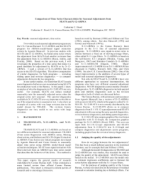
An official website of the United States government
Here’s how you know
Official websites use .gov
A .gov website belongs to an official government organization in the United States.
Secure .gov websites use HTTPS
A lock (
) or https:// means you’ve safely connected to the .gov website. Share sensitive information only on official, secure websites.
-
//
- Census.gov /
- Library /
- Census Working Papers /
- Comparison of Time Series Characteristics for Seasonal Adjustments
Comparison of Time Series Characteristics for Seasonal Adjustments from SEATS and X-12-ARIMA
Comparison of Time Series Characteristics for Seasonal Adjustments from SEATS and X-12-ARIMA
Abstract
Two widely-used seasonal adjustment programs are the U.S. Census Bureau's X-12-ARIMA and the SEATS program for ARIMA-model-based signal extraction written by Agustin Maravall. In previous studies with SEATS and X-12-ARIMA, we found some series where the adjustment from SEATS had smaller revisions than the adjustment from X-12-ARIMA (Hood, Ashley, and Findley, 2000). Based on this previous work, I will investigate the properties of a time series that make it a good candidate for adjustment by SEATS or by X-12-ARIMA. I used a version of X-12-ARIMA that has access to the SEATS algorithm. This allows computation of similar diagnostics for both programs — including sliding spans and revision diagnostics — to compare adjustments between the two programs.
In our earlier studies, we found that SEATS needs more diagnostics before we can recommend using SEATS for production work at the Bureau. In this paper, I show examples of why the diagnostics in X-12-SEATS are very useful. For example, SEATS can induce residual seasonality into the seasonally adjusted series when the original series isn't seasonal. The spectral diagnostics available in X-12-SEATS are very important to be able to see if the original series is seasonal or not. I also show an example of a series with very large revisions due to the model chosen by TRAMO. The revision history diagnostics are very useful to see series with large revisions.
Others in Series
Working Paper
Working Paper
Working Paper
Share
Related Information
Some content on this site is available in several different electronic formats. Some of the files may require a plug-in or additional software to view.
 Yes
Yes
 No
NoComments or suggestions?


Top

